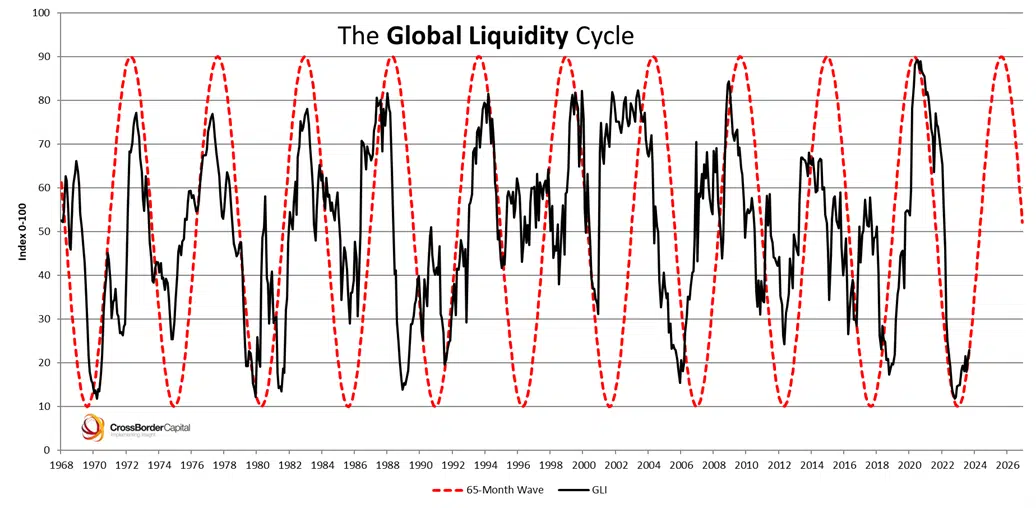Timing Bitcoin’s next cycle top as 2024 halving nears

- Projections showed that liquidity would reach a local peak in September 2025.
- The Bitcoin cycle is fueled by the available liquidity.
Bitcoin [BTC] has moved within roughly four cycles, with each new cycle marking a new all-time high for the prices.
From being used to pay for pizza to having multinational investment companies market the spot BTC ETF to their customers, the crypto community has been on some ride over the past decade and then some.
Along comes a bull run every three or four years. And we are on the eve of another one, which has likely started. But why do we have these cycles, and are they predictable?
The basic answer might not be the whole truth
Avid crypto users would immediately respond that the Bitcoin halving cycle is timed on a four-year clock.
The mining difficulty and block time are adjusted in such a way that the mining rewards are halved roughly once every four years.
So, there you go. Each additional miner in the network sees the hash rate and security increase, but the block time keeps getting adjusted.
To justify the mining costs, Bitcoin’s price has to go up, and the halving puts even more upward pressure.
However, like everything, the answer has more nuances. Bitcoin and the rest of the crypto market represent an extremely volatile asset class. They come with a large amount of associated risk.
Fraud, security (individual or even exchange, they are all vulnerable to hackers), regulatory oversight, and volatility are just some of them.
Liquidity is a key component to understanding the four-year cycle
When the economy is in a rough spot, securing funds for investment is more difficult. This means safer assets are in demand.
Conversely, when liquidity is abundant, the public is more open to dipping their toes into riskier asset classes, with crypto being one of them.

Source: CrossBorder Capital
The Global Liquidity Index (GLI) chart ranges from 0-100 and captures the Global Liquidity Cycle as a normalized index.
The COVID-19 pandemic forced the monetary policy toward lowering the cost of debt and quantitative easing.
This sparked a rise in inflation that the US Federal Reserve, for example, has been fighting over the past two years by raising interest rates. As of 2024, their stance is that the rates will likely not be hiked again.

Source: CrossBorder Capital
A 65-month sine wave (repeating cycle) was a rough approximation of each cycle. While it isn’t perfect, it doesn’t need to be.
It allows us to extrapolate and have an idea of when the next cycle’s peak or low could arrive.
Is Bitcoin’s cycle top near?
The data showed that the next cycle’s top would be in Q4 2025, around September. This tied in well with a previous, fun experiment that AMBCrypto attempted using the Bitcoin Rainbow Chart.
We also found that Bitcoin took close to three years to go from December 2018 lows at $3.1k to the November 2021 high of $69k.
Bitcoin took 1435 days to go from the 2017 cycle high to the 2021 high. This translates to 47.17 months, which is short of the 65-month cycle of the index.
However, the most recent GLI high and low in 2021 and 2023 somewhat line up with the MVRV ratio of Bitcoin.

Source: CryptoQuant
At press time, the MVRV ratio has been in a year-long uptrend. It was nowhere close to the cycle top value of 3.7, meaning that BTC prices likely have more room to expand.
So, the date of September 2025 might not line up with a Bitcoin top, either.
Read Bitcoin’s [BTC] Price Prediction 2024-25
The influx of institutional investors has ramped up demand for BTC in the long run, but has it also lengthened the approximately three years that BTC took in the previous cycle to go from bottom to top?
Only with time will we know the definite answer.






